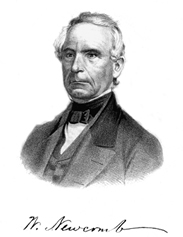Hawai’i is (or was) home to a great diversity of tree snails in the families Achatinellidae and Amastridae. It seemed as if every valley on every island had its own suite of species. Many were quite common. But that was then. Now they have been decimated by the introduction, accidental or otherwise, of invasive hogs and other animals brought by European settlers. Some species, even an entire genus, have become extinct.
Wesley Newcomb (1808-1892) was a physician, social activist, and conchologist. Born in New York, he moved from Albany to California in 1849, then to Hawai’i in 1850 due, in part, to his wife’s ill health. There he practiced medicine, served on the Board of Health, became active in the Hawaiian Temperance Movement, and collected a lot of shells. In 1855 he returned to Albany. His collection was purchased by Ezra Cornell, founder of Cornell University, for $15,000, and it resides there still. An avid shell collector, Newcomb traveled to Europe, the West Indies, and Central and South America. He described over 100 species, including many Hawai’ian Achatinellidae and Amastridae.
The Division of Molluscs has a modest collection of Hawai’ian Achatinellidae and Amastridae originating from Newcomb. The collection was either purchased by or traded with Henry Moores in the mid-1800’s. (Henry Moores, 1812-1896, assembled one of the most diverse shell collections of his time. The Ohio State University purchased this collection, 3,500 specimens for $1,750, about 1890). Card stock used for labels cut from postcards date from the 1850s. The collection has an accompanying list of specimens, some notes, and a short letter to Moores. The curious, printed handwriting matches that of Newcomb’s labels now at the Paleontological Research Institute at Ithaca, New York, and there is no doubt that they are Newcomb’s specimens. Specimens have as many as six labels, with different numbers, in the same vials. However, according to Newcomb’s accompanying list, he inserted “card” labels with a number that matched the number on the list. These card labels, often small squares, have numbers written by Newcomb’s hand and can easily be discerned from the later labels added to the specimens. Some specimens are numbered in ink or pencil, but these numbers were added by Moores. The specimens were apparently sent to Moores after Newcomb’s return to the mainland.
Some aspects of the collection are interesting from a personal view of Newcomb. Many of the specimens were dirty and bear on the small card labels the advice “wash them” (we have carefully done so in a sonic cleaner). The list arrived before the shells as Newcomb tells Moores to “Wait for the Waggon! (Express)” And one label bears the opinionated observation: “‘guernea‘ W.H.P. [crossed out, then added:] A. perversa? Swains. ‘guernea‘ of some fool.” Newcomb’s “fool” was apparently contemporary fellow Hawai’ian conchologist, William Harper Pease.
Below are some of Newcomb’s own specimens now in the Division of Molluscs.
About the Author: Dr. G. Thomas Watters is the Curator of Molluscs.










